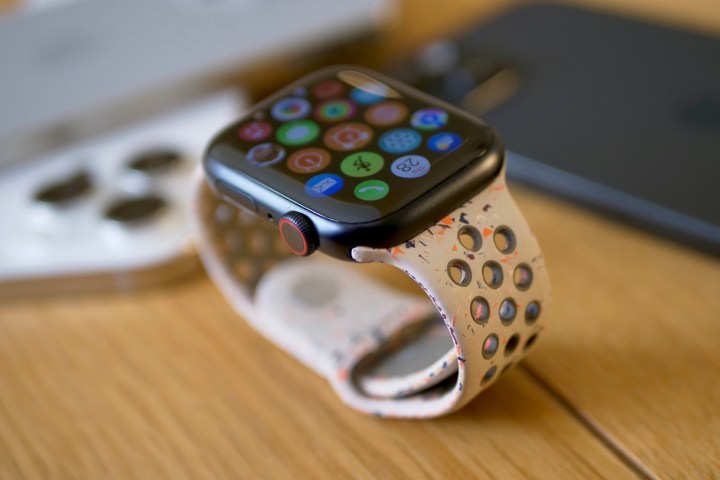The Apple Watch has officially crossed the 10-year mark, which is a huge milestone. It’s a decade of a smartwatch that has changed the industry for good, put smartwatches on the map, and even saved lives.
If you’re in the market for a smartwatch and health tracker, then you really can’t go wrong with an Apple Watch, especially if you are already vested in the Apple ecosystem. But should you buy the Apple Watch Series 10 over the Series 9? Or, if you already have a Series 9, is the Series 10 worth the upgrade cost? Let’s break it all down.
Apple Watch Series 10 vs. Apple Watch Series 9: specs
| Apple Watch Series 10 | Apple Watch Series 9 | |
| Size | 42mm
46mm |
41mm
45mm |
| Dimensions | 46mm x 39mm x 9.7mm (46mm)
42mm x 36mm x 9.7mm (42mm) |
45mm x 38mm x 10.7mm (45mm)
41mm x 35mm x 10.7mm (41mm) |
| Weight | 36.4 grams (aluminum, GPS, 46mm)
35.3 grams (aluminum, GPS + Cellular, 46mm) 41.7 grams (titanium, 46mm) 30 grams (aluminum, GPS, 42mm) 29.3 grams (aluminum, GPS + Cellular, 42mm) 34.4 grams (titanium, 42mm) |
38.7 grams (aluminum, GPS, 45mm)
39 grams (aluminum, GPS + Cellular, 45mm) 51.5 grams (stainless steel, 45mm) 31.9 grams (aluminum, GPS, 41mm) 32.1 grams (aluminum, GPS + Cellular, 41mm) 42.3 grams (stainless steel, 41mm) |
| Colors | Jet Black aluminum
Rose Gold aluminum Silver aluminum Slate Titanium Gold Titanium Natural Titanium |
Starlight aluminum
Midnight aluminum Silver aluminum PRODUCT(RED) aluminum Pink aluminum Gold (stainless steel) Silver (stainless steel) Graphite (stainless steel) |
| Display | LTPO3 OLED Always-on Retina display
Wide-angle OLED Up to 2000 nits brightness 1 nit minimum brightness 416 x 496 pixel resolution, 1220 sq mm display area (46mm) 374 x 446 pixel resolution, 989 sq mm display area (42mm) 40% brighter when viewed at an angle |
LTPO OLED Always-on Retina display
Up to 2000 nits brightness 1 nit minimum brightness 396 x 484 pixel resolution, 1143 sq mm display area (45mm) 352 x 430 pixel resolution, 904 sq mm display area (41mm) |
| Processor | S10 SiP with 64-bit dual-core processor
W3 Apple wireless chip Second-generation Ultra Wideband 4-core Neural Engine |
S9 SiP with 64-bit dual-core processor
W3 Apple wireless chip Second-generation Ultra Wideband 4-core Neural Engine |
| Storage | 64GB | 64GB |
| Health and fitness tracking | Electrical heart sensor (ECG)
Third-generation optical heart sensor Cycle Tracking Nightly wrist temperature tracking Sleep tracking Sleep apnea notifications Vitals app (heart rate, respiratory rate, wrist temperature, sleep duration) Depth gauge Water temperature sensor |
Electrical heart sensor (ECG)
Third-generation optical heart sensor Cycle Tracking Nightly wrist temperature tracking Sleep tracking Sleep apnea notifications Vitals app (heart rate, respiratory rate, wrist temperature, sleep duration) |
| Double Tap | Yes | Yes |
| Battery life | Up to 18 hours
Up to 36 hours in Low Power Mode |
Up to 18 hours
Up to 36 hours in Low Power Mode |
| Charging | 0-80% in 30 minutes | 0-80% in 45 minutes |
| Price | Starting at $399 (GPS only)
Starting at $499 (GPS + Cellular) |
Available at authorized retailers |
| Review | Coming soon | Apple Watch Series 9 review |
Apple Watch Series 10 vs. Apple Watch Series 9: design
The Apple Watch has largely stayed the same in terms of aesthetics year after year (with the exception being the Apple Watch Ultra). But things have changed a bit this year with Apple Watch Series 10.
The Apple Watch Series 9 looks like all of the Apple Watches before it. Shaped like a rounded square, with body made from aluminum or stainless steel and a ceramic and sapphire crystal back, the Series 9 comes in either 41mm or 45mm sizes. The aluminum has a matte finish, while the stainless steel is polished and glossy. The aluminum Series 9 comes in Midnight, Starlight, Silver, Pink, and Product(RED) colorways, while the stainless steel variant comes in silver or Space Black.

Apple has shaken things up with the Apple Watch Series 10. Though it retains the same “squircle” shape as before, Apple has made the body thinner and display larger. It comes in two new sizes: 42mm and 46mm. With the 46mm size, the display is actually a bit larger than even the 49mm Apple Watch Ultra thanks to the new wide-angle OLED display, which expands farther down the sides of the case than before, making it easier to see your watch from an angle.
The Apple Watch Series 10 also is the first time that Apple eliminated stainless steel from the color lineup. Instead, the Series 10 now comes in aluminum or titanium. Aluminum Apple Watch Series 10 models come in rose gold, silver, and a new jet black finish that looks polished and glossy. For titanium, it comes in slate, gold, or natural.
Before the announcement, there were whispers that Apple would change up the watch band attachment system, but thankfully (or not, depending on how you look at it), that did not change.
Apple Watch Series 10 vs. Apple Watch Series 9: display

The display on the Apple Watch Series 10 is a big improvement over its predecessor, especially with the 46mm version.
Both the Apple Watch Series 9 and Series 10 use an always-on OLED display, but the Series 10’s display now expands farther down the sides of the case. This is beneficial because it lets the wearer see what is on the screen at an angle, so there’s no need to move your wrist as much. The display is also 40% brighter when viewed at an angle, improving visibility further.
Apple says that the 46mm Apple Watch Series 10’s display is 30% larger than previous generations, and is actually bigger than the Apple Watch Ultra display. A larger screen means you can see more text, type with the on-screen keyboard easier, and even get more features on the watch face, such as a seconds-ticker for the clock.
The brightness levels between the Series 10 and Series 9 remain the same at up to 2,000 nits peak brightness, and down to 1 nit in low-light environments.
Apple Watch Series 10 vs. Apple Watch Series 9: health and fitness tracking

Over the years, Apple has continued to add new health features and sensors to the Apple Watch, and the Apple Watch Series 10 continues that trend.
The Apple Watch Series 10 has all of the basic features of the Series 9 that came before it: heart rate tracking, ECG, wrist temperature sensor, sleep tracking, and more. During the keynote, Apple showed off the Apple Watch Series 10’s sleep apnea detection, but this feature is also coming to the Series 9 and Apple Watch Ultra 2, so it’s not a reason to upgrade.
It was originally thought sleep apnea detection would require blood-oxygen monitoring, which isn’t currently available on U.S. Apple Watches because of the Masimo lawsuit. However, Apple has a workaround utilizing the accelerometer instead to measure sleep movement. It will analyze the collected data every 30 days, and if there are possible signs of sleep apnea, a report is generated. The feature is pending FDA approval, but Apple hopes it will be cleared soon.
For swimmers, Apple has added more health features on the Apple Watch Series 10 that you’ll appreciate. It now has a depth gauge and water temperature sensor, just like on the Apple Watch Ultra 2. However, while the Ultra 2 can be used to dive 40 meters (130 feet), the Series 10 can only go down 6 meters (20 feet). You can also get the Oceanic+ app on the Series 10 and Ultra 2, but not with the Series 9.
Apple Watch Series 10 vs. Apple Watch Series 9: software and performance

The Apple Watch Series 9 originally shipped with watchOS 10, but it is upgradeable to watchOS 11. Inside, it houses the S9 SiP that allows for faster, on-device Siri with localized access to Health data, and brings the Double Tap gesture for one-handed Apple Watch use for certain actions.
The Apple Watch Series 10 ships with watchOS 11 out of the box. Apple included a faster S10 Sip inside that, when combined with the new wide-angle OLED, means even more power efficiency.
One of the big new features in watchOS 11 is the new Vitals app. This doesn’t give you new data, but takes your existing health information and presents it in a new light. There are five key metrics: heart rate, respiratory rate, wrist temperature, blood oxygen, and sleep duration. With Vitals, when you wear your Apple Watch to sleep, it shows you how those metrics did overnight. It’s an easier way to see if there’s something you should be concerned about.
One should expect at least several years of support for any Apple Watch, including the Series 9 and Series 10. Apple doesn’t give a specific time frame, but it will last a while.
Apple Watch Series 10 vs. Apple Watch Series 9: battery and charging

In terms of battery life, the Apple Watch Series 10 is about the same as its predecessor, with up to 18 hours with normal use, or up to 36 hours in Low Power Mode.
However, when it comes to charging, Apple made improvements this year with the Series 10. Previously, the Apple Watch Series 9 would go from 0% to 80% battery in about 45 minutes. But with the Series 10, you can go from 0% to 80% in 30 minutes.
Since there is more reason to wear your Apple Watch to bed, having faster charging is a good factor to consider when purchasing.
Apple Watch Series 10 vs. Apple Watch Series 9: verdict

If you already have an Apple Watch Series 9, an upgrade to the Series 10 is a hard sell. After all, the Series 9 is getting sleep apnea detection as well, and unless you plan on doing a lot of snorkeling, the depth gauge and water temperature sensors are cool, but not a necessity.
However, if you’re coming from an older Apple Watch, or even from an Apple Watch Ultra model, then the Apple Watch Series 10 is definitely appealing. It’s thinner but has the largest display (with the 46mm) on an Apple Watch, even beating out the Apple Watch Ultra. And with the wide-angle OLED and increased brightness, it’s easier to see your watch face at an angle.
Though some were expecting bigger changes with the Apple Watch Series 10, Apple has streamlined and refined its iconic wearable. If you’re in the market for an upgrade, then the Apple Watch Series 10 is looking like a good option. But if you decide to go for its predecessor, it’s a good time for some deals too.







